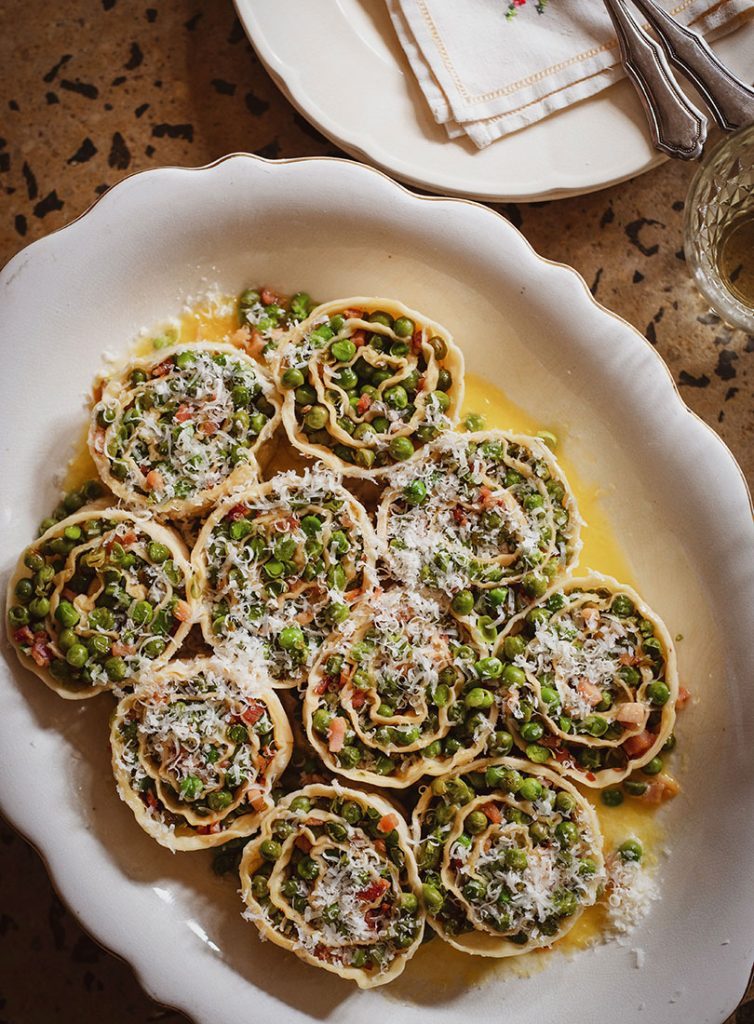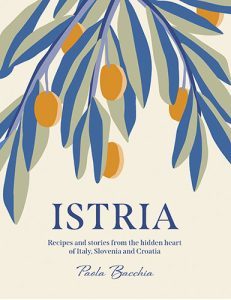Pasta Strudel With Peas & Pancetta (Strucolo In Straza Con Piselli E Pancetta)
Paola Bacchia

Serves
4Ingredients
| FOR THE PASTA | |
| 250g (1⅔ cups) ‘00’ pasta flour, plus extra for dusting | |
| 2 eggs | |
| 2-3 tablespoons water | |
| FOR THE FILLING | |
| 125g pancetta, finely diced | |
| 15g unsalted butter | |
| 1 tablespoon olive oil | |
| 1 garlic clove, thinly sliced | |
| 500g frozen baby peas | |
| sea salt and freshly cracked black pepper | |
| 60ml (¼ cup) Béchamel sauce (see recipe) | |
| TO SERVE | |
| 100g unsalted butter, melted | |
| a few handfuls of grated parmesan |
The influence of the Hapsburgs on food can be seen in the strudels that you will find across much of northern Italy, the Istrian peninsula and down the Dalmatian coast. They are more commonly sweet, but also savoury; the pastry might be an egg pasta dough, a yeasted bread-like dough or a fine olive oil pastry. This version is called strucolo in straza in dialect – literally, ‘strudel in a cloth’. It is made of egg pasta, and cooked by being immersed in boiling water.
My version with peas and pancetta is inspired by Annetta in Iolanda de Vonderweid’s recipe book. You will need a very large rectangular pan to cook the strucolo flat; I use a fish pan. Others join up the two ends of the strudel to make a kind of circle that is cooked by being lowered into a large, deep pot, attached by a long string to a strong wooden spoon that sits across the top of the pot. Whichever method you choose, the strudel should be fully immersed in water while it cooks.
View the recipe collection here
Instructions
| 1. | To make the pasta, place the flour on your work surface in a mound and make a well in the centre. |
| 2. | Crack the eggs into the well. |
| 3. | Start whisking the liquid gently with the tines of a fork, incorporating a bit of flour at the same time. |
| 4. | Keep whisking, making an ever-widening circle as you incorporate more flour. |
| 5. | The mixture will eventually become too thick for you to use the fork, so start using your fingertips, working the wet ingredients into the dry ingredients until you have used up most of the flour and a ball of dough forms. |
| 6. | You may need to add a bit of water/flour to get the right consistency. |
| 7. | Knead for about 10 minutes, or until the dough is smooth and elastic. |
| 8. | Place on a plate, cover with an upturned bowl and allow to rest for at least 30 minutes. |
| 9. | While the pasta is resting, make the filling. |
| 10. | Place the pancetta in a large frying pan with the butter and olive oil. |
| 11. | Cook over medium-low heat for about 5 minutes, or until the pancetta renders its fat. |
| 12. | Add the garlic and sauté until fragrant, then add the peas. |
| 13. | Cover and braise for about 30 minutes over low heat, until the peas are well cooked and soft, adding a bit of water as needed. |
| 14. | Add salt and pepper to taste. Set aside to cool while you roll out the pasta. |
| 15. | After your dough has rested, dust your work surface with semolina. |
| 16. | Cut off half the dough and keep the rest covered. |
| 17. | Roll out the dough portion with a rolling pin until it is thin enough to go through the widest setting of your pasta machine. |
| 18. | Thread it through the rollers of the machine, turning the handle to make the rollers move. |
| 19. | Allow the pasta sheet to drop from the machine. |
| 20. | Fold the thinned sheet in half, dust it with semolina if it is sticky, and give it a quarter turn, before threading it through the machine again. |
| 21. | The quarter turn means that the pasta is going through the machine in a different direction and is essentially being kneaded. As you continue to fold, roll and turn the dough, the gluten will start to work, and it will become firmer and smoother. |
| 22. | Repeat as many times as needed to make the dough lose much of its stretch (usually five or six times) and look somewhat glossy. |
| 23. | Try to keep the dough in a rectangular shape, especially at the end of this process; you may need to use the rolling pin to help you shape it. |
| 24. | Once the dough has become firm and glossy, start turning the dial of the machine so the rollers are closer together, rolling the dough thinner each time. |
| 25. | You no longer need to give the dough a quarter turn, and you will only need to roll it once through each setting. |
| 26. | Dust the pasta sheets with semolina if the dough sticks to the machine as it goes through. |
| 27. | Repeat until your pasta is rolled thinly enough – usually the second-last setting of your pasta machine, then repeat with the other portion of dough. |
| 28. | To make a large pasta sheet, you will need to join the sheets together, using a little water to seal the edges together. |
| 29. | You will need a rectangle of pasta measuring about 30cm x 50cm. |
| 30. | Alternatively, if you are an experienced pasta maker, you can roll out the whole lot by hand until you have a single rectangle of dough the same size. |
| 31. | Dust a large, clean tea towel of the same size with extra flour. |
| 32. | Lift the rectangle of dough onto the tea towel. |
| 33. | Spread a thin layer of béchamel sauce over the dough, leaving a 10cm-wide border on one short edge and a 2cm border around the other edges. |
| 34. | Spoon the cooled pancetta and pea filling over the sauce. |
| 35. | Using the tea towel to help you, carefully lift one short edge so that the pasta rectangle slowly rolls onto itself, towards the 10cm free edge of pasta. |
| 36. | Some of the peas may spill out of the sides as you roll the pasta sheet; if so, stop and lift them back onto the pasta sheet. |
| 37. | The roll will need to be fairly tight so that the filling stays in place. |
| 38. | Secure the ends tightly with kitchen string or elastic bands. |
| 39. | Loosely secure the middle of the cloth-covered roll, in three or four places. |
| 40. | Fill a large 35cm-wide saucepan with water and bring to the boil, adding a large pinch of salt. |
| 41. | Carefully lower the cloth roll into the water using tongs. |
| 42. | Once the water comes back to the boil, simmer for 40 minutes. |
| 43. | Carefully remove the roll from the pan and place on a wire rack to drain. |
| 44. | Undo the kitchen string and lift the cooked pasta roll onto a chopping board. |
| 45. | Cut into 3-4cm thick slices. |
| 46. | Carefully lift the slices using a spatula and arrange on individual warmed plates, or a serving platter. |
| 47. | Surround the slices with any filling that has dropped out. |
| 48. | To serve, spoon melted butter over the top and scatter with parmesan. |
 This is an edited
This is an edited
extract from Istria
by Paola Bacchia,
published by Smith
St Books, $65.
Photographs by
Paola Bacchia.
